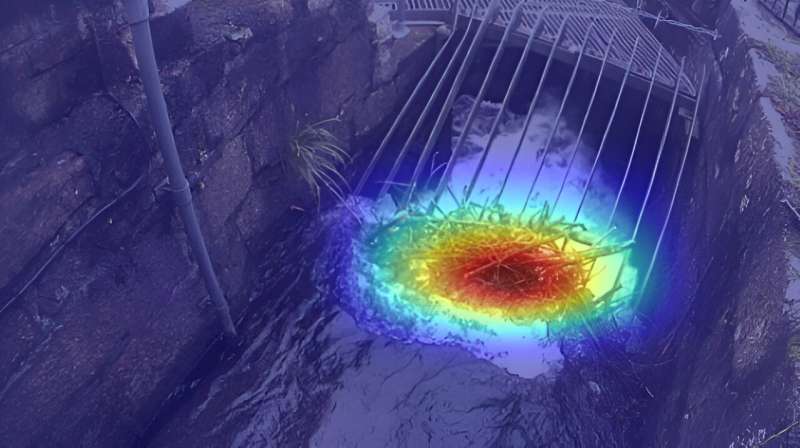
October 9, 2024 by University of Bath
Collected at: https://phys.org/news/2024-10-ai-cctv-rivers-blockages.html
Smart CCTV systems trained to spot blockages in urban waterways could become an important future tool in flood prevention, new research published Oct. 3 in the Journal of Flood Risk Management has found.
Researchers at the University of Bath have shown that their AI-enabled detection software, “AI on The River” trained to accurately detect natural debris, litter or waste blocking trash screens mounted in culverts, can be integrated into existing CCTV systems to provide an early warning of likely flooding.
Culverts, which number more than 1 million in the U.K. and are in almost every city, town or built-up area, allow streams and rivers to flow under roads, railway embankments and housing developments, meaning they are an important but hidden part of waterways and infrastructure. Trash screens, usually a set of bars, are mounted at culvert entrances to stop debris from passing through.
When a culvert trash screen is blocked, flooding can happen quickly. If the flow of water into a culvert is restricted, it can build up and pool, leading to risks to the structural integrity of the waterway and the local environment.
Helping flood defenses worldwide
The machine learning process created by the team is already attracting attention from flood prevention organizations in countries including South Africa, where monitoring equipment is available but data that could be used to train an AI to do the same job is scarce or not collected.
Dr. Andrew Barnes, a lecturer in Bath’s Department of Computer Science and a member of the Center for Climate Adaptation & Environment Research, and the team that developed the software underpinning the early warning system. He said, “We’ve been able to develop an efficient model that can capture and identify blockages before they become a problem—it’s proactive, so it doesn’t wait for a flood to happen before raising the alarm.
“We’ve developed the system to be flexible and scalable—it could be applied almost anywhere, giving it huge potential in countries where flooding is an issue but where the resources to develop similar tools locally may be scarce.”
Identifying blockages with high accuracy
Focusing on a culvert site in Cardiff, the team used machine learning to train a camera system to automatically spot potential obstructions, resulting in it being able to identify likely blockages with close to 90% accuracy. In most cases in the U.K., culverts are monitored manually over CCTV by local authority staff watching a bank of screens.
Using AI and machine learning to create early warning systems would allow local authorities in charge of keeping waterways flowing to focus resources where they are needed and respond to potential blockages quickly and in a focused way.
The proactive nature of the system also offers major safety benefits to response teams, as they can attend sites immediately rather than having to work in dangerous flooded conditions.
Dr. Thomas Kjeldsen, a Reader in Bath’s Department of Architecture & Civil Engineering and a member of the Center for Regenerative Design and Engineering for a Net Positive World (RENEW), added, “Climate change means the risk of flooding is growing all around the world.
“This work opens the potential for the development of new, lightweight and cost-efficient flood management systems in urbanized areas, enabling authorities around the globe to adapt to the changing climate. This study is a first step toward a sustainable solution to flood forecasting, and it has opened a multitude of areas for exploration and exploitation.”
More information: Rory Cornelius Smith et al, CCTV image‐based classification of blocked trash screens, Journal of Flood Risk Management (2024). DOI: 10.1111/jfr3.13038

Leave a Reply